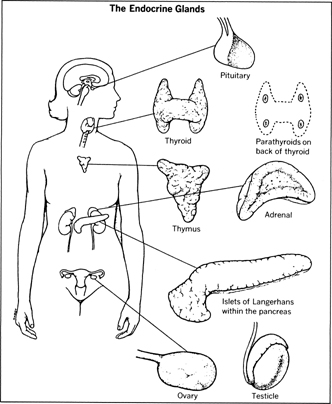Diseases of the Endocrine Glands
G lands are organs that produce and secrete substances essential for normal body functioning. There are two main types of glands: the endocrine and the exocrine . The endocrines, or ductless , glands send their secretions directly into the bloodstream. These secretions, which are biochemically related to each other, are called hormones . The exocrines, such as the sebaceous or sweat glands, the mammary (or milk) glands, and the lachrymal (or tear) glands, have ducts that carry their secretions to specific locations for specific purposes.
The exocrine glands are individually discussed elsewhere in connection with the various parts of the body where they are found. This section is devoted to diseases of the ductless glands, which include:

- • The pituitary , which controls growth and the activity of the adrenal, thyroid, and sex glands
- • The thyroid , which controls the rate of the body's chemical activity or metabolism
- • The adrenals , which affect metabolism and sex characteristics
- • The male gonads or testicles and the female gonads or ovaries
- • The parathyroids , which regulate bone metabolism
Unlike the exocrine glands, which can function independently of one another, the endocrines form an interrelated system. Thus a disorder in one of them is likely to affect the way the others behave. Glandular disorder can sometimes be anatomical, but it is usually functional. Functional disease can result in the production and release of too little or too much of a particular secretion.
When too much of a hormone is being secreted, the prefix hyper- is used for the condition, as in hyperthyroidism . When too little is being secreted, the prefix hypo- is used, as in the word hypofunction , to indicate that a gland operates below normal.
Abnormalities of the endocrine glands that cause changes in their functioning are responsible for a wide variety of illnesses. These illnesses are almost always accompanied by symptoms that can be recognized as distinctly abnormal. Prompt and accurate diagnosis can usually prevent the occurrence of irreversible damage. For many people with glandular disorders, treatment may have to be lifelong. They can feel well and function almost normally, but they must follow a program of regulated medication taken under a physician's supervision.
The Pancreas
The pancreas, a combined duct and endocrine gland, is to some extent regulated by the anterior pituitary. See Ch. 15, Diabetes Mellitus , for a discussion of the pancreas and diabetes.

Comment about this article, ask questions, or add new information about this topic: